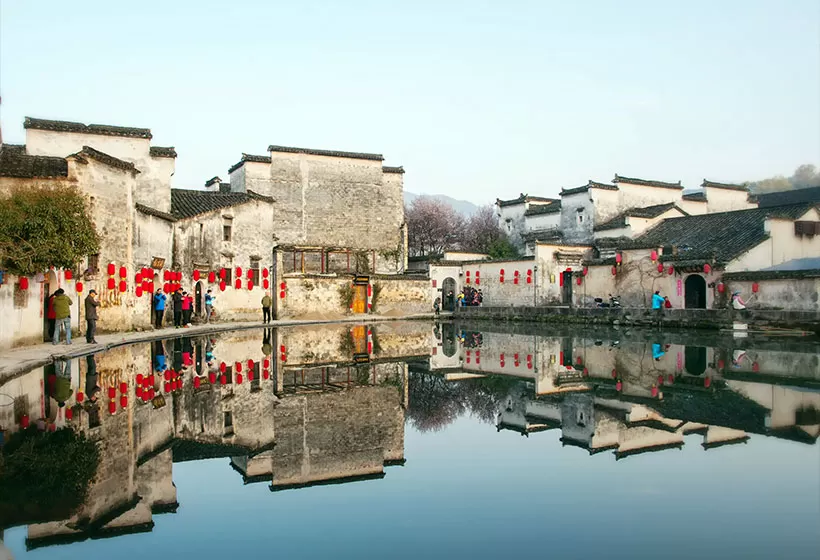Hongcun Village
A brief of History
Hongcun Village is located in the Yixian County of Anhui Province. It is one of the representative ancient villages in the southern region of Anhui Province. First, it was built in 1131 A.D.. The village now has a history of almost 1,000 years. The ancient Hongcun villagers adopted “bionics” to the design of buildings and constructed a cattle-shaped village and man-made water system that has been called as“a uniqueness of China”. The bird’s eye view of the village resembles a large buffalo perking its head and lifting its legs. This can be said as one of the wonders in the history of construction. Today, the water system, streets, folk houses and even interior arrangements of the village are completely preserved in their primitive condition from the past.
Now, there are more than 140 well-preserved ancient houses that date back to the Ming and Qing Dynasties. The beautiful and imposing Chengzhi Hall in Hongcun is representative of the ancient houses in the southern part of Anhui Province. The wooden decoration of the construction of Chengzhi Hall is so beautiful that no other buildings can be comparable to it. Also, there are many layers and characters and facial expressions. They can be said for the fine works among the wood carvings in the “Three Carvings” art of Anhui Style.
The Moon Pond and South Lake of the Hongcun Village have the most charming natural scenery. The Moon Pond is a half-moon-shaped pond that is as smooth as a mirror and remains year-round. Blue and white clouds all drop into the pond, the sight of which is so attractive that one can find it hard to turn away. The South Lake is located in the southern part of the Hongcun Village. It is a man-made lake constructed by mimicking the model of West Lake and the famous South Lake College that are situated along its sides. A lot of poets and painters from ancient times to the present day have written and drawn various poems and paintings here.
The exquisitely arranged yards and buildings of Hongcun and the beautiful landscapes help to reflect the beauty of one another. There, visitors can find sceneries everywhere and every place is picturesque featuring natural beauty. The traditional countryside scenery of China which has changed in the last century has been well preserved there. As a result, the village is called the “village in traditional Chinese painting.” In 1999, Hongcun Village, together with Xidi Village was evaluated as a “World Cultural Heritage Site” by UNESCO.
In Xidi and Hongcun, two traditional ancient towns, the local people have had the same lifestyle throughout the last century without making many changes to the town. The style of the street, the ancient buildings, the decorations, and the homes equipped with complete water supply systems are all cultural heritages unique to these two ancient towns.
Introduction
As part of the Huangshan scenic area, Xidi and Hongcun are the two most representative ancient villages among all homes in southern Anhui Province. They have a worldwide reputation for the dreamlike pastoral scenery, well-preserved village ensemble, the exquisite homes of the Anhui architectural style.
The location, layout, and architectural style of Xidi and Hongcun are deeply influenced by the fengshui theory put forward in The Book of Changes, embodying a perfect combination of man and nature. They also show that nature is revered in ancient Chinese philosophies. The elegant homes and nature just live side by side in harmony, creating a sound living environment. Thus, they are regarded as the essence of traditional Chinese homes. The unique water network is a shiny example for the combination of utility and aesthetic value. In particular, the ox-shaped water network in Hongcun demonstrates human wisdom in making use of natural resources to work for people’s benefit
More about Hongcun Village
Originally built in the first year of the Zhaoxing Period of the Southern Song Dynasty (1131 AD), Hongcun is 10 kilometers squared to the northeast of Yi County, with an area of approximately 19 hectares. Currently, there are 137 ancient buildings originally built in the Ming and Qing Dynasties (1368-1911 AD). The village hailed as the most beautiful in China is veiled in the mist for its high altitude.
The ancient buildings in the village, well arranged and perfectly fit into the whole layout, are constructed with black tiles and light-colored bricks. Among them, the most magnificent and exquisite is Chengzhi Hall, also known as the Forbidden City outside the royal court. Additionally, there is an exhibition hall that displays the best pieces of wood carvings of the Anhui style. The lifelike wood carvings, though subject to the test of time for hundreds of years, are still rich in details and leave visitors with a great impression.
Hongcun comes in the shape of an ox. From a distance, it resembles a buffalo drinking water by the river. The crescent-shaped pond in the middle of the village just looks like the stomach of the ox. Within, there flows a creek that meanders 400 meters squared, resembling the shape of the intestine of the ox. On the western side of the village, four bridges are erected over the river, resembling the legs of the ox. The unique design of the water network in the village not only offers convenience for the local people for production, water accessibility, and firefighting while helping regulate the temperature and environment.
Cultural Heritages
Originally built in the Zhaoxi Period of the Southern Song Dynasty (1190-1194 AD), Hongcun used to be the former home of the Family Wang, enjoying a history of over 800 years. It leans against Yangzhan Hill, a mountain range of Huangshan, and is commonly seen veiled in the mist for its high altitude. From a distance, it just resembles a scroll of landscape paintings unfolding in front of you. Due to this, it is hailed as a village in the ink and wash painting.
The ox-shaped water network in the village is thought to be a wonder in the history of architecture. Within the village, Leigang Hill resembles the head of the ox, the trusting ancient trees the horns, and the well-arranged homes of the body. In the past, the local people dug waterways in the village, resembling the intestine of the ox. The water meanders through the village and finally flows into a crescent pond, which is regarded as the stomach of the ox. Also, there are four bridges erected over the rivers flowing by, resembling the legs of the ox. The unique design of the water network makes it possible for the local people to have easy access to water for firefighting, helps regulate the temperature, and provides them with many conveniences in their daily life. In this environment, each household can have easy access to water and use water to put out fires once the houses catch fire. Today, there are 140 existing ancient homes of the Ming and Qing Dynasties that have an antique style. Chengzhi Hall is acclaimed as the best of the homes in southern Anhui for its magnificence and exquisite carvings. The pavilions, mansions, lakes, and rocks in Nanhu Academy are just interwoven as a whole, adding more charm to one another. This is regarded as the typical Anhui architectural style. Jingxiu Hall, Dongxian Hall, Sanli Hall, and Xuren Hall are either magnificent or solemn. Scattered with thrusting ancient trees, ivy-covered walls, and peonies in the courtyard, the village will amaze you with its changing scenery.
FABULOUS TOUR COMPANY
CHINA OCTOBER - NOVEMBER 2019 We researched several companies and studied reviews on Trip Adviser before contacting who did a very China Culture Tour with an initial query. Right from the outset Grace who owns the company was excellent. She emailed detailed with pictures information and a suggested…read more details
Karen from US
Ready to Create a Unique Dream Travel?

